Randy's Gazebo (LC) |
 The only shark I saw the entire trip, Reef Shark with a Jack (probably Horse-Eye) and a couple of Bar Jack. The only shark I saw the entire trip, Reef Shark with a Jack (probably Horse-Eye) and a couple of Bar Jack.
1/80-F5.6-ISO500 lens: 18-55mm |
 Larry and I were easy to pick out in the water - our do-rags were quite distinctive. Larry and I were easy to pick out in the water - our do-rags were quite distinctive.
1/80-F5.6-ISO500 lens: 18-55mm |
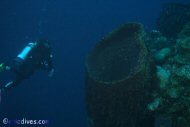 Divemaster Marc rounds the corner past a couple of very large barrel sponges. Divemaster Marc rounds the corner past a couple of very large barrel sponges.
1/80-F5.6-ISO500 lens: 18-55mm |
 A shot of a large barrel sponge. A shot of a large barrel sponge.
1/80-F5.6-ISO500 lens: 18-55mm |
 Spiny Lobster. These guys tended to be quite large. Spiny Lobster. These guys tended to be quite large.
1/80-F5.6-ISO800 lens: 18-55mm |
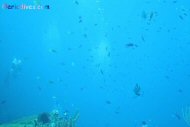 The usual reef fish were abundant: there's Brown Chromis, at least one Black Durgon, and quite a few Creole Wrasse in this picture. The usual reef fish were abundant: there's Brown Chromis, at least one Black Durgon, and quite a few Creole Wrasse in this picture.
1/80-F5.6-ISO800 lens: 18-55mm |
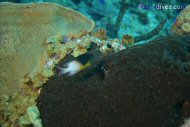 A Bicolor Damselfish. A Bicolor Damselfish.
1/80-F5.6-ISO800 lens: 18-55mm |
 Easy to ID with his black saddle, this is a Nassau Grouper. Easy to ID with his black saddle, this is a Nassau Grouper.
1/80-F5.6-ISO800 lens: 18-55mm |
 There's always one that has to go against the flow ... these are probably Mahogany Snapper. There's always one that has to go against the flow ... these are probably Mahogany Snapper.
1/80-F5.6-ISO800 lens: 18-55mm |
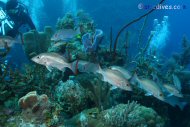 Some more Mahogany Snapper. Some more Mahogany Snapper.
1/80-F5.6-ISO800 lens: 18-55mm |
 What you can barely make out just right of center at the bottom of this Giant Anemone is a Squat Anemone Shrimp. Seeing that little guy dictated a lens change for the next dive ... What you can barely make out just right of center at the bottom of this Giant Anemone is a Squat Anemone Shrimp. Seeing that little guy dictated a lens change for the next dive ...
1/80-F5.6-ISO800 lens: 18-55mm |
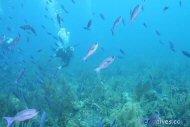 Whenever I see Creole Wrasse they're always in very large schools. Whenever I see Creole Wrasse they're always in very large schools.
1/80-F5.6-ISO800 lens: 18-55mm |
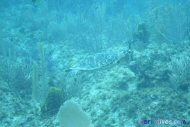 This turtle was a delight to see. I just couldn't really get a good shot, or didn't set the camera up right to take a good shot ... This turtle was a delight to see. I just couldn't really get a good shot, or didn't set the camera up right to take a good shot ...
1/80-F5.6-ISO800 lens: 18-55mm |
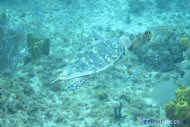 That didn't stop me from trying. That didn't stop me from trying.
1/80-F5.6-ISO800 lens: 18-55mm |
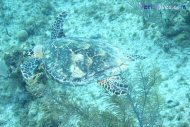 And trying ... And trying ...
1/80-F5.6-ISO800 lens: 18-55mm |
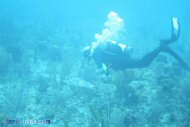 Dale keeps the little guy company. Dale keeps the little guy company.
1/80-F5.6-ISO800 lens: 18-55mm |
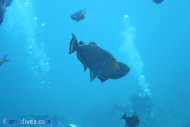 Black Durgon have some brilliant coloration on their bodies, particularly their heads. However, they're so skittish you can't get close enough for a flash to light it up, and it's so dark that you need to get close to accurately light it up ... Black Durgon have some brilliant coloration on their bodies, particularly their heads. However, they're so skittish you can't get close enough for a flash to light it up, and it's so dark that you need to get close to accurately light it up ...
1/100-F5.6-ISO800 lens: 18-55mm |
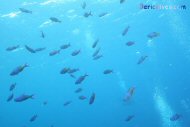 And again, more Creole Wrasse. And again, more Creole Wrasse.
1/100-F5.6-ISO800 lens: 18-55mm |
 Peering over the Bloody Bay Wall ... Peering over the Bloody Bay Wall ...
1/100-F5.6-ISO800 lens: 18-55mm |
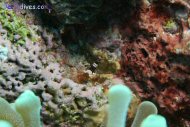 When I got back down, I made a beeline for that Squat Anemone Shrimp. He wasn't an easy subject to get. When I got back down, I made a beeline for that Squat Anemone Shrimp. He wasn't an easy subject to get.
1/60-F10-ISO500 lens: 100mm macro |
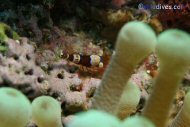 The eyes look kind of strange and make the entire shot seem somewhat out of focus. The eyes look kind of strange and make the entire shot seem somewhat out of focus.
1/60-F10-ISO500 lens: 100mm macro |
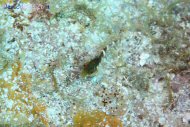 It wasn't uncommon to come across a blenny on a dive; here's what I think at first glance might be a Saddled Blenny. It wasn't uncommon to come across a blenny on a dive; here's what I think at first glance might be a Saddled Blenny.
1/60-F10-ISO500 lens: 100mm macro |
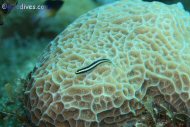 A Sharknose Goby, sitting on some coral. A Sharknose Goby, sitting on some coral.
1/125-F10-ISO500 lens: 100mm macro |
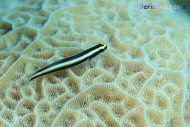 He let me get pretty close, which isn't always the case. He let me get pretty close, which isn't always the case.
1/125-F10-ISO500 lens: 100mm macro |
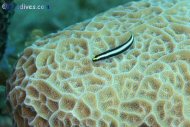 He even turned around to let me get a shot of his other side. He even turned around to let me get a shot of his other side.
1/125-F10-ISO500 lens: 100mm macro |
 The blennies usually let me get pretty close too, but they never did let me get a decent side shot so I could have a better chance to ID them ... The blennies usually let me get pretty close too, but they never did let me get a decent side shot so I could have a better chance to ID them ...
1/125-F10-ISO500 lens: 100mm macro |
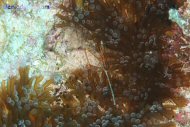 Arrow Crab hiding in what I think is a Knobby Anemone. Arrow Crab hiding in what I think is a Knobby Anemone.
1/125-F10-ISO500 lens: 100mm macro |
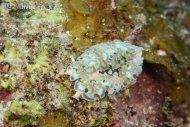 Lettuce Sea Slugs are so cool looking, in my opinion. I took many a photo of this guy. Lettuce Sea Slugs are so cool looking, in my opinion. I took many a photo of this guy.
1/125-F10-ISO500 lens: 100mm macro |
 I resisted the temptation to edit this image to black out the background more. If I knew then what I knew now, I'd have played with my settings quite a bit to get that done naturally. I resisted the temptation to edit this image to black out the background more. If I knew then what I knew now, I'd have played with my settings quite a bit to get that done naturally.
1/125-F10-ISO500 lens: 100mm macro |
 The head of a Hind or Graysby - can't be 100% sure without more of the body, but I was shooting macro ... The head of a Hind or Graysby - can't be 100% sure without more of the body, but I was shooting macro ...
1/80-F14-ISO400 lens: 100mm macro |
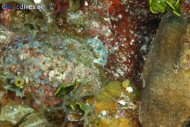 Another Lettuce Sea Slug. Another Lettuce Sea Slug.
1/80-F14-ISO400 lens: 100mm macro |
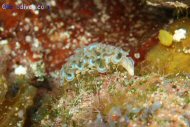 1/80-F14-ISO400 lens: 100mm macro 1/80-F14-ISO400 lens: 100mm macro |
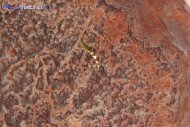 As I look at the photos of this and similar fish, I'm more certain that it's a Saddled Blenny. As I look at the photos of this and similar fish, I'm more certain that it's a Saddled Blenny.
1/80-F14-ISO400 lens: 100mm macro |
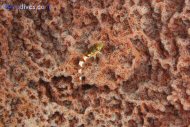 1/80-F14-ISO400 lens: 100mm macro 1/80-F14-ISO400 lens: 100mm macro |
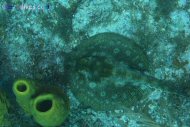 A small Yellow Stingray. I had to get pretty far away to get this much of him in the photo, even though he wasn't that big. I should have tried for an eye shot. A small Yellow Stingray. I had to get pretty far away to get this much of him in the photo, even though he wasn't that big. I should have tried for an eye shot.
1/80-F14-ISO400 lens: 100mm macro |
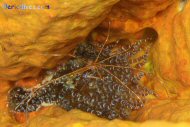 Though he was in a tough spot, I managed to get my strobes positioned to get several decent shots of this Arrow Crab with a Corkscrew Anemone. Though he was in a tough spot, I managed to get my strobes positioned to get several decent shots of this Arrow Crab with a Corkscrew Anemone.
1/80-F14-ISO400 lens: 100mm macro |
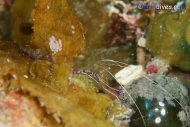 If you come to my site often, you'll know I'm a fan of Pedersen Cleaner Shrimp. If you come to my site often, you'll know I'm a fan of Pedersen Cleaner Shrimp.
1/80-F14-ISO400 lens: 100mm macro |
The Meadow/Jackson's Bight (LC) |
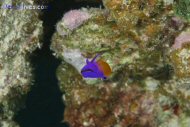 Fairy Basslet. They were always under an overhang, swimming upside down. Fairy Basslet. They were always under an overhang, swimming upside down.
1/80-F14-ISO400 lens: 100mm macro |
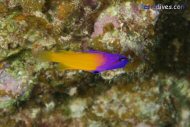 1/80-F14-ISO400 lens: 100mm macro 1/80-F14-ISO400 lens: 100mm macro |
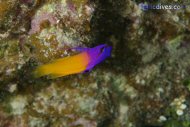 1/80-F14-ISO400 lens: 100mm macro 1/80-F14-ISO400 lens: 100mm macro |
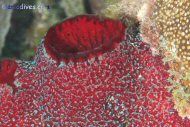 These look black under water, but if you light them up with a flash, you see that they are actually a bright red. These look black under water, but if you light them up with a flash, you see that they are actually a bright red.
1/80-F14-ISO400 lens: 100mm macro |
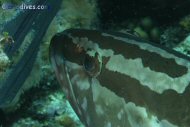 On this Nassau Grouper are what appear to be at least one, possibly two parasitic isopods. On this Nassau Grouper are what appear to be at least one, possibly two parasitic isopods.
1/80-F14-ISO400 lens: 100mm macro |
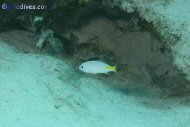 A Juvenile Blackfin Snapper, I think. A Juvenile Blackfin Snapper, I think.
1/80-F14-ISO400 lens: 100mm macro |
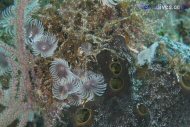 Some Social Feather Dusters. Some Social Feather Dusters.
1/80-F14-ISO400 lens: 100mm macro |
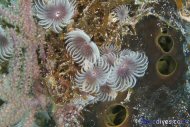 1/80-F14-ISO400 lens: 100mm macro 1/80-F14-ISO400 lens: 100mm macro |
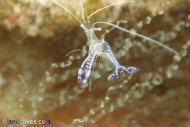 As I like Pedersen Cleaners, it's great when I can get a shot of one doing something I haven't seen it do before, like swim! As I like Pedersen Cleaners, it's great when I can get a shot of one doing something I haven't seen it do before, like swim!
1/80-F14-ISO400 lens: 100mm macro |
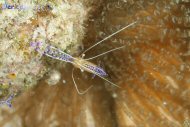 He made it back home. He made it back home.
1/80-F14-ISO400 lens: 100mm macro |
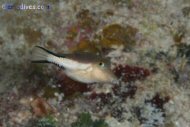 Not always easy to shoot, Sharpnose Puffer fish can vary in size from very small to small, and tend to dart around a lot. Many a photographer has gotten Puffer butt attempting to get a shot of the neat eyelash like markings on their eyes. Not always easy to shoot, Sharpnose Puffer fish can vary in size from very small to small, and tend to dart around a lot. Many a photographer has gotten Puffer butt attempting to get a shot of the neat eyelash like markings on their eyes.
1/80-F14-ISO400 lens: 100mm macro |
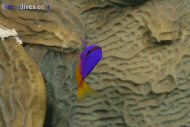 Another Fairy Basslet. Another Fairy Basslet.
1/80-F10-ISO400 lens: 100mm macro |
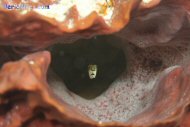 An example of Puffer butt, as he darts into a sponge in an attempt to hide. An example of Puffer butt, as he darts into a sponge in an attempt to hide.
1/80-F10-ISO400 lens: 100mm macro |
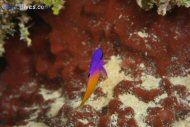 The top side of a Fairy Basslet, who tend to dart around more than Puffers so much that I'm never quite sure if the shot came out. The top side of a Fairy Basslet, who tend to dart around more than Puffers so much that I'm never quite sure if the shot came out.
1/80-F10-ISO400 lens: 100mm macro |
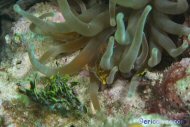 A Diamond Blenny hiding in a Giant Anemone. A Diamond Blenny hiding in a Giant Anemone.
1/80-F10-ISO400 lens: 100mm macro |
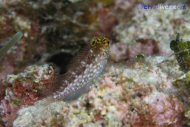 Not quite Diamond Blenny butt. Not quite Diamond Blenny butt.
1/80-F10-ISO400 lens: 100mm macro |
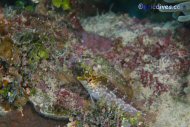 I've had less cooperative photography subjects in my time. I've had less cooperative photography subjects in my time.
1/60-F10-ISO400 lens: 100mm macro |
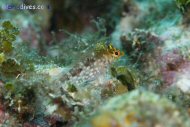 1/60-F10-ISO400 lens: 100mm macro 1/60-F10-ISO400 lens: 100mm macro |
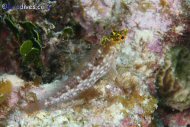 1/60-F10-ISO400 lens: 100mm macro 1/60-F10-ISO400 lens: 100mm macro |
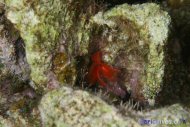 A Star Horseshoe Worm. This photo marks the start of the night dive. A Star Horseshoe Worm. This photo marks the start of the night dive.
1/60-F10-ISO400 lens: 100mm macro |
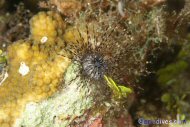 A Long-Spined Urchin. A Long-Spined Urchin.
1/60-F10-ISO400 lens: 100mm macro |
 A Stingray that I didn't get all that close to. A Stingray that I didn't get all that close to.
1/60-F10-ISO400 lens: 100mm macro |
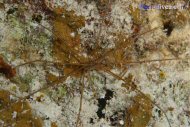 An Arrow Crab out and about, looking for some food. An Arrow Crab out and about, looking for some food.
1/60-F10-ISO400 lens: 100mm macro |
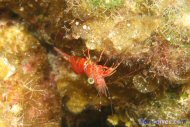 Red Night Shrimp are very shy - their eyes are easy to spot at night, as they glow red in the distance when you aim your flashlight at them. However, if you get too close, they dart away. If I managed to get one to hang around after one flash shot, they usually darted away after the second one. Red Night Shrimp are very shy - their eyes are easy to spot at night, as they glow red in the distance when you aim your flashlight at them. However, if you get too close, they dart away. If I managed to get one to hang around after one flash shot, they usually darted away after the second one.
1/60-F10-ISO400 lens: 100mm macro |
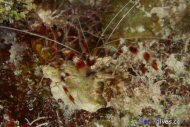 I hadn't quite gotten the secrets of macro photography down when I snapped this shot - and the other 20 or so of this same subject. This one came out, but more often than not something about this Banded Coral Shrimp would be sharply in focus (say, a claw), while the rest of the body would be blurry. I hadn't quite gotten the secrets of macro photography down when I snapped this shot - and the other 20 or so of this same subject. This one came out, but more often than not something about this Banded Coral Shrimp would be sharply in focus (say, a claw), while the rest of the body would be blurry.
1/60-F10-ISO400 lens: 100mm macro |
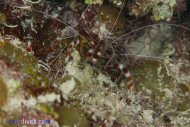 Depth of field (which is a "measure" of how much of the subject is in focus) is influenced by f-stop/aperture value, and the distance from the subject. Here, my distance from the shrimp (because I wanted to get as much of his antennae in the shot as possible) made it easier to get more of him in focus. Depth of field (which is a "measure" of how much of the subject is in focus) is influenced by f-stop/aperture value, and the distance from the subject. Here, my distance from the shrimp (because I wanted to get as much of his antennae in the shot as possible) made it easier to get more of him in focus.
1/60-F10-ISO400 lens: 100mm macro |
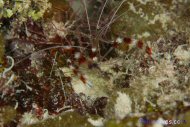 Here's an example where depth of focus isn't ideal - note the left claw is a bit blurry. Here's an example where depth of focus isn't ideal - note the left claw is a bit blurry.
1/60-F10-ISO400 lens: 100mm macro |
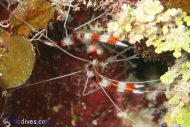 Though they usually dislike nosy divers with cameras almost as much as Red Night Shrimp, this Banded Coral Shrimp was a very tolerant subject. Though they usually dislike nosy divers with cameras almost as much as Red Night Shrimp, this Banded Coral Shrimp was a very tolerant subject.
1/60-F10-ISO400 lens: 100mm macro |
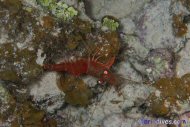 Red Night Shrimp are usually very small, but some of these guys were 2-3 inches long in the body. Red Night Shrimp are usually very small, but some of these guys were 2-3 inches long in the body.
1/60-F10-ISO400 lens: 100mm macro |

































































